Royal supporters of England facts for kids
The royal supporters of England are special animal figures that stand on either side of the royal arms of England. Think of them as guardians for the king or queen's shield! Over the years, English monarchs have used many different real and imaginary animals as their supporters. These have included lions, leopards, panthers, tigers, antelopes, deer, greyhounds, boars, bulls, falcons, cocks, eagles, swans, and even red and gold dragons. Today, the royal arms are supported by a lion and a unicorn.
Meet England's Royal Animal Helpers
| Monarch (Years Ruled) | Supporters Used | Fun Facts About Their Supporters | Coat of Arms |
|---|---|---|---|
 House of Plantagenet House of Plantagenet  (1327–1399) |
|||
 King Edward III (1327–1377) |
|
King Edward III might have used a golden lion on one side and a silver falcon on the other. However, we don't have clear proof that kings used official animal supporters this early. Sometimes, two angels were shown with his shield. |
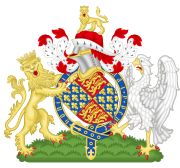 lion and falcon |
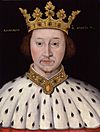 King Richard II (1377–1399) |
|
King Richard II famously used two white deer, called "harts," as his supporters. You can see them on Westminster Hall. The deer had collars and chains, which was a special symbol from his mother, Joan of Kent. |
 two harts |
(1399–1413) |
|||
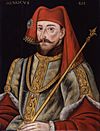 King Henry IV (1399–1413) |
|
King Henry IV might have used a lion and an antelope, or an antelope and a swan. The swan symbol came from his first wife's family, the de Bohuns. The antelope was also linked to the Bohun family. |
 lion and antelope |
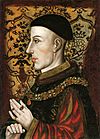 King Henry V (1413–1422) |
|
King Henry V used a golden lion on one side and a silver antelope on the other. These were similar to the animals his father, Henry IV, used. |
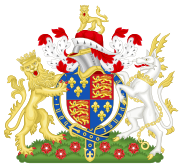 lion and antelope |
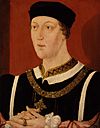 King Henry VI (1422–1461) |
|
King Henry VI's arms often showed two antelopes. He might have been the first English king to regularly use supporters as part of his official coat of arms, rather than just as decorations. |
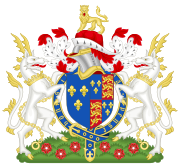 two antelopes |
 House of York House of York  (1413–1485) |
|||
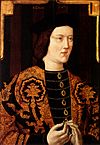 King Edward IV (1461–1483) |
|
King Edward IV often used two white lions. These lions were a symbol of the Mortimer family, from whom he was descended. Sometimes, he also used a black bull or a white deer (hart) as a supporter. |
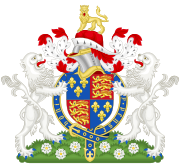 two lions |
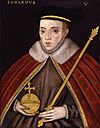 King Edward V (1483) |
|
This young king, who ruled for a very short time, used the same supporters as his father: a white lion and a white deer (hart or hind). |
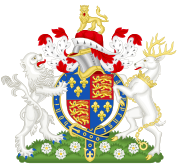 lion and hart |
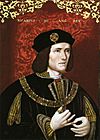 King Richard III (1483–1485) |
|
King Richard III was well known for using two white boars as his main supporters. The white boar was his personal symbol even before he became king. |
 two boars |
(1485–1606) |
|||
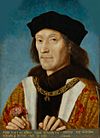 King Henry VII (1485–1509) |
|
King Henry VII used a red dragon and a white greyhound. The red dragon was a symbol of his Welsh ancestors. The white greyhound was a symbol from his wife's family, the House of York, or possibly his mother's family, the Beauforts. |
 dragon and greyhound |
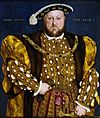 King Henry VIII (1509–1547) |
|
At first, King Henry VIII used the same supporters as his father: a red dragon and a white greyhound. Later, he changed them to a crowned golden lion and a red dragon. |
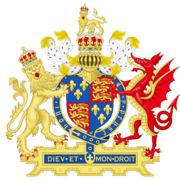 lion and dragon |
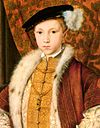 King Edward VI (1547–1553) |
|
King Edward VI used the same supporters as his father, Henry VIII, in the later part of his reign: a golden lion and a red dragon. |
 lion and dragon |
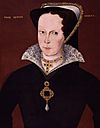 Queen Mary I (1553–1558) |
|
Queen Mary I used a black eagle and a crowned golden lion. The eagle was a symbol from her husband, Philip II of Spain. |
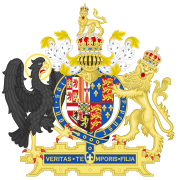 eagle and lion |
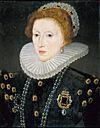 Queen Elizabeth I (1558–1603) |
|
Queen Elizabeth I used the same supporters as her father, Henry VIII: a crowned lion and a dragon. Sometimes the dragon was shown in gold instead of red. |
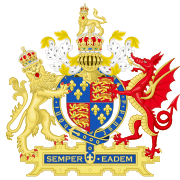 lion and dragon |
 House of Stuart House of Stuart  (1603–1649) |
|||
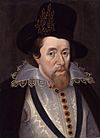 King James I (1603–1625) |
|
When King James VI of Scotland also became King James I of England, he brought a new supporter: the Scottish unicorn. Since then, the royal arms of England have been supported by a golden lion and a silver unicorn. |
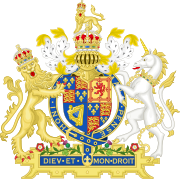 lion and unicorn |
 King Charles I (1625–1649) |
|
King Charles I used the same supporters as his father, James I: the crowned golden lion and the silver unicorn. |
 lion and unicorn |
(1653–1659) |
|||
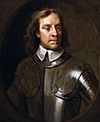 Oliver Cromwell (1653–1658) |
|
During the time of Oliver Cromwell, when England was a republic, the royal symbols changed. The unicorn was replaced with the red dragon, a symbol from the Tudor period. This showed a clear break from the Stuart kings. |
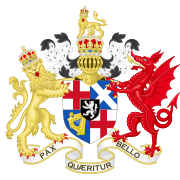 lion and dragon |
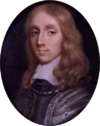 Richard Cromwell (1658–1659) |
|
Richard Cromwell, Oliver's son, used the same lion and red dragon supporters during his short time in power. |
 lion and dragon |
 House of Stuart (Restored) House of Stuart (Restored)  (1660–1707) |
|||
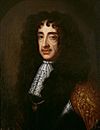 King Charles II (1660–1685) |
|
After the monarchy was restored, King Charles II brought back the traditional crowned golden lion and silver unicorn as his supporters. |
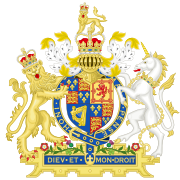 lion and unicorn |
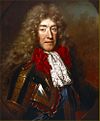 King James II (1685–1688) |
|
King James II also used the crowned golden lion and silver unicorn as his royal supporters. |
 lion and unicorn |
 King William III and Queen Mary II (1689–1694) |
|
King William III and Queen Mary II continued to use the crowned golden lion and silver unicorn as their supporters. |
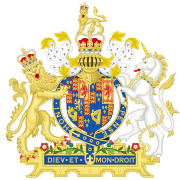 lion and unicorn |
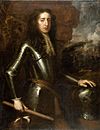 King William III (1689–1702) |
|
After Queen Mary's death, King William III continued to rule alone, using the same lion and unicorn supporters. |
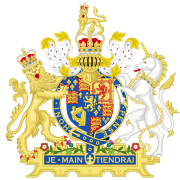 lion and unicorn |
 Queen Anne (1702–1707) |
|
Queen Anne, the last Stuart monarch, also used the crowned golden lion and silver unicorn as her royal supporters. |
 lion and unicorn |
See also
- The Lion and the Unicorn
- The Queen's Beasts

